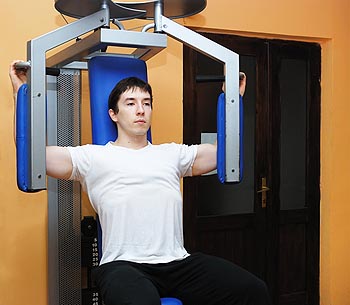How to Use the Pec Deck Machine
This machine works the chest muscles which consist mainly of the pectoralis major and the pectoralis minor. Due to the positioning of this machine, the anterior, or front deltoid (shoulder muscle), may also be worked to some extent.
Setting up the machine
- Adjust the seat so that your feet sit comfortably on the floor and your forearms are positioned comfortably against the arm pads. Keeping the arms open and at a horizontal position, bend the elbows and press the forearms against the cushioning and wrap your hands firmly around the handlebars.
- Set the desired weight load.
How to use
- Lean back and keep your back pressed against the back rest, knees straight and feet flat on the floor. Be careful not to arch your back as this will place unnecessary stress on your lower back.
- Take a deep breath in and as you exhale, bring your arms inwards leading with your elbows but ensuring you donít lift your arms off the padding, until the two levers just about touch.
- Do not let the levers touch; it is important to keep the movement controlled throughout.
- Hold for a count of one and as you inhale return to the starting position.
- Likewise, do not let the weight plates touch between repetitions.
- Do not put your back into the movement, i.e. donít push the weight with your back. If the weight load is too heavy decrease it and rather focus on strengthening the chest.
Variations
The correct way for using this machine is as shown in the image below. However, some may find it more comfortable to bring their arms slightly downwards and grasp their hands onto the padding instead of the handlebars (particularly women). You can also perform this move with arms straight out in front of you, palms facing each other. This variation targets a different region of your pecs, however, it is important to ensure you are familiar with the correct and standard form before trying new variations.

Author: Dimi Ingle.
Copyright 2009: Remedium. This article may not be copied, in whole or in part, without the written consent of Remedium.
|